Referendum votes are supposed to narrow as the day of reckoning nears. In the recent referendum on the Eighth Amendment, what happened to turn this conventional wisdom on its head?
An Ipsos MRBI poll for The Irish Times in January showed 66 per cent in favour of repeal (excluding undecideds). By April it has fallen slightly to 63 per cent. One month later and with just 10 days to go, support had slipped to 58 per cent – a steady decline in support, in line with the pattern of previous referendums.
As we now know, an emphatic 66 per cent voted in favour of repeal. Instead of narrowing, the gap widened over the final 10 days of campaigning.
With the benefit of hindsight, we can reasonably conclude the No side made inroads in the early days of campaigning. The No campaign appeared to be faster out of the blocks.
The Claire Byrne Live debate now looks like the high watermark for the No vote, but at the time – 10 days out – the Yes vote was sliding and anything seemed possible.

To get a better understanding of what turned the tide for the Yes side, Ipsos MRBI polled the general public on which of the various forms of communication or campaigning they felt exerted the greatest influence on the outcome. Voters were asked immediately following the referendum, while the result was still fresh in their minds.
Despite pre-referendum polling data showing about half of voters to be uncomfortable sharing their views in public, discussions around the referendum were reckoned by voters to have been critical in deciding the outcome.
In total, 39 per cent of those polled cited some form of discussion as having the most influence on how people voted in the end – discussion on social media was mentioned by 24 per cent and discussion in pubs, at work or at home received 15 per cent of mentions.
Sharing views
It is little surprise that discussions with family, friends and colleagues were seen to have made the difference. Sharing views is intrinsic to every referendum and election – kitchen tables, water coolers and the local pub have always fed the discussion and will continue to play their part, with social media an increasingly important forum in this regard.
Also, at a very primitive level, discussion can give us a sense of belonging, by identifying others with whom we share common values and positions. Discussion on social media, for example, left young people in very little doubt that by voting Yes they would be part of broad consensus in favour of change.
Which raises the question: what were voters talking about on social media and elsewhere because something happened in the final week to turn the tide in favour of a Yes vote?
TV and radio debates can change the mood of a nation. From these debates we get a sense of how the country is feeling, because we know everyone is watching
Media debates were the difference. TV debates were mentioned by 25 per cent of voters as having the greatest impact, with radio debates cited by a further 9 per cent.
Almost everyone will remember the “who do you think won” conversations had in offices, homes or on Twitter the morning following a debate. Debates shape the discussion because of the enormous reach they can deliver. They are the events in every campaign that engage and entertain us the most.
Over one million people tuned into either or both the Primetime or Claire Byrne Live debates. More would have watched debates on other channels or listened to one of the radio debates.
Nation’s mood
TV and radio debates can change the mood of a nation. From these debates we get a sense of how the country is feeling, because we know everyone is watching.
The timing of debates is also crucial, scheduled for critical stages in the campaign.
Opinion polls prior to the campaign had identified a large swathe of the population leaning towards repeal while also holding the opinion that abortion on request should not be made legal. For this cohort, doubt was a constant companion, and arguably the debates convinced these voters that compromise was the right choice.
To put the power of debates in context, we can compare their influence with other media or communications tools available to campaigners.
According to the public, next to TV debates (25 per cent of mentions) and radio debates (9 per cent) in order of influence were posters (7 per cent), newspaper commentary (3 per cent) and canvassing (3 per cent). Fewer mentions were given to online advertising (2 per cent), billboard advertising (2 per cent), on-street leafleting (1 per cent) and announcements at Mass (1 per cent).
In the final week of the campaign, the Yes side won the debate battle. Their arguments were cohesive and persuasive. Their performances were confident. They created a mood and a momentum that secured a decisive win.
Damian Loscher is managing director of Ipsos MRBI











